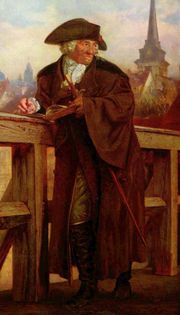
Born: October 16, 1726, Gdansk , Polish-Lithuanian Commonwealth (presently Poland)
Died: February 7, 1801, Berlin, Prussia
Early days. He always proudly remembered his Polish and French Huguenot ancestry, as his father, Gottfried was a Polish grain merchant and his mother, born in Switzerland, was a Huguenot. When his father died, both Daniel (aged 16) and his younger brother Gottfried went to live with their uncle in Berlin. He offered to educate them and Daniel received an artistic training with the painter Haid in Augsburg. His brother also became a painter.
Artistic carreer. Soon Daniel was able to earn a living by painting. He was admitted to the Berlin Academy in 1764 and became vice-director under B. Rode in 1788. He had found his true calling and became the most famous German graphic artist of his time. Artwork of Chodowiecki is quiet impressive – almost 900 aquafortes- his favorite technique, 30 oil paintings and over 4000 hand drawings. The bulk of his work was in illustrating scientific books by Basedow, Buffon, Lavater, Pestalozzi and others. His prints represent in great detail the life of the middle classes during the Zopfstil period, a time between Rococo and Classicism. In 1797 Chodowiecki was appointed director of the Academy of Arts in Berlin. Firstly he painted oil on canvas, won his fame on picture "Jean Calas' Farewell to Family.” His portrait engravings were based mainly on paintings by Anthon Graaf or his own sketches from nature. The artist's greatest masterpiece will always remain the series of 108 drawings made during his horse trip to Poland and his hometown, Gdansk, in 1773. This was his first return after 30 years absence and he went specifically to see in Gdansk his elderly mother and sisters. He made only one more trip to Gdansk afterwards, to her funeral. He describes and illustrates towns and people in Pomerania and Prussia on the way. They are full of personal passion and indescribable atmosphere. Artist did use them as a kind of note of the present moment just like we use photography nowadays. He sketched his family house and the simple life of his beloved city and its neighborhood. We observe variability of Poland in 18th century. He also painted many portraits of Polish gentry and was interested in Huguenot and Polish history as well, making some paintings on the topic. He was in tune with the developing spirit of the age, and many works reflect the cult of sensibility, and then the revolutionary and German nationalist feelings of the end of the century. In printmaking, he is credited with the invention of the deliberate remarque, a small sketch on a plate, lying outside the main image. These were originally little sketches or doodles by artists, not really meant to be seen, but Chodowiecki turned them into "bonus items" for collectors. Chodowiecki, speaking Polish, French and German, many times also declared his Polish allegiance and had his son Isaac Heinrich, born in Berlin, painted as a very young child with a Polish outfit and haircut. In a letter to Józef Łęcki, the Polish astronomer, he wrote: "I consider it to be an honor to be a true Pole, even though I am now living in Germany." Because of his mother's and his wife's Huguenot descent he was very close to the Huguenots of Berlin. One of his most popular books is Journey from Berlin to Gdansk (German: "Die Reise von Berlin nach Danzig", 1773) with many illustrations. Daniel Chodowiecki is buried at the Französischer Friedhof in Berlin.
.
Source:
This article uses, among others, material from the Wikipedia article "Daniel Chodowiecki" licensed under the GNU Free Documentation License. :
Wikipedia
Other sources:
Bildindex(German):Photos of many of his works
Malarze (also photos of several of his drawings)
Return to home page:
Prominent Poles